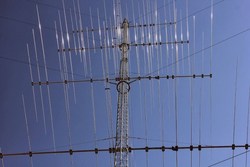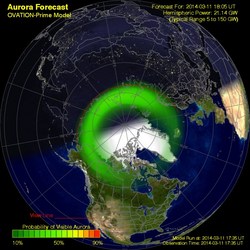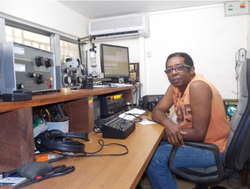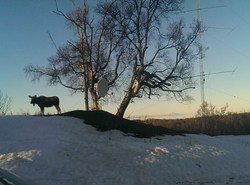 March 12, 2014 Editor: Ward Silver, NØAX | |||||||||||||||||||||||||||||||||||||||||||
IN THIS ISSUE
NEW HF OPERATORS - THINGS TO DO The Russian DX Contest is a great opportunity to do some contesting on both modes this weekend and experience conditions around the spring equinox. The equinox is a special time when the terminator between day and night areas goes directly over both poles, leading to interesting gray line DX. BULLETINS Quick - before you forget! - upload some photos and stories about your ARRL DX experiences to the ARRL Soapbox website. Conditions were great, logs were full, memories were made - why not share them? BUSTED QSOS A good accuracy rate in the previous issue. CONTEST SUMMARY Complete information for all contests follows the Conversation section March 15-16 North American Sprint--Phone
March 22-23
CWops contests are doubling down (or is that doubling up?) in March. Hank W6SX announces, "In addition to our regular tests on 12 and 26 March, we will have special CWTs on 5 and 19 March. The Special 5- and 19-March CWTs will celebrate the completion of CW Academy's January/February semester from which sixty eager hams will graduate." For these contests, Hank requests that we limit our code speed to 20 wpm or the speed at which a station calls. Relax, exchange names, take time to explain the exchange if needed, and make a special effort to work the new operators. Sending a QSL wouldn't hurt either! We can also let our club members know of this special opportunity to get into a CW contest at their speed. Chris W2PA spotted this blog entry about a 1978-vintage space probe returning to Earth, but NASA doesn't have a radio that can talk to it. Could the ham radio community play a useful role here? DX Engineering has been busy lately, acquiring Cycle 24 Antenna Products. Cycle 24's product line includes the TX38 Yagi which is the official triband antenna being used by all stations in the upcoming WRTC-2014. The antenna is lightweight at 30 pounds but features eight full-sized elements (two elements each on 20 and 15 meters and four elements on 10 meters). The product line extends to heavy-duty galvanized parts such as saddle clamps and U-bolts for antenna construction along with the EA4TX ARS-USB Rotator Controller Interface.
JK Antennas and 2X Arrays are combining their design and manufacturing processes. JK Antennas produces long-boom mono-band and duo-band antenna designs while 2X Arrays develops proprietary antenna design processes ranging from electrical optimization to physical model electrical testing and tuning. The 2X Arrays antenna line will now be manufactured at the JK Antennas facility in Connecticut. (Thanks,Matt W1MBB) In another example of ham radio setting the stage for innovation, Ann Makosinski, daughter of Arthur and Sandra Ann Makosinski (VE7FAB and VE7EEL), created a novel LED flashlight powered by heat from the hand holding it. The project won for her age group in the 2013 Google Science Fair. Requiring no batteries or other power sources, the flashlight can provide light in areas without electricity or other reliable and affordable power sources. (Thanks, Jim KØUPW) As long as we're on the subject of portable power, on the 145th birthday of the periodic table, the Better-Batteries-Through-Chemistry Department has come up with a material that combines polymerized sulfur with a form of benzene into a co-polymer. Batteries made with electrodes using the new material have extremely high specific energy. Research is continuing to find variations on the material that offer longer life and higher numbers of charge/discharge cycles. In a twist on the customary repeater directory. Radio Amateurs of Canada has turned to the online service RF Finders to create a "live" repeater directory. (Thanks, Ken KØPP) Here's what you really want to know in a product review - knob feel! (Thanks, Kirk K4RO) Goetz DJ3IW writes with news of changes to the former DRCG Long Distance Contest (LDC). The contest has been renamed to: DRCG-WW-RTTY contest and will be held in three 8-hour sections on the second full weekend of June. You can find all of the rules on the contest's website. A busy reader, Eric W3DQ sent two interesting articles. The first, on the mysterious "numbers stations" describes these odd signals and their ability to continue "baffling the boffins" as our U.K. friends might say. Closer to home, the iconic KRKD broadcast towers in downtown Los Angeles are getting a makeover.
The National Oceanic and Atmospheric Administration (NOAA) has created a new online aurora prediction tool called OVATION. The software was created at the Johns Hopkins University Applied Physics Lab. OVATION is driven by real-time solar wind and interplanetary magnetic field information from the Advanced Composition Explorer (ACE) satellite. The model is based on more than 11 years of data from the Defense Meteorological Satellite Program (DMSP) from which an empirical relationship between the solar wind conditions and the aurora location and intensity was developed. (From ARRL Propagation Bulletin ARLP009) Two unexpected Silent Key announcements came our way this past week. The first, NQ4I team member Mark W4SVO died on Monday March 3rd. Mark was a dedicated low-band enthusiast who designed much of the 80/160 meter skyhooks at NQ4I. Elsewhere, Mike N1IW, a frequent member of the record-setting C6ANM contest team died after a long battle with cancer. Mike was also a WRTC-2014 volunteer. Entirely too many Silent Keys lately - I hope my readers will avoid that designation. (Thanks, Rick NQ4I, Bill NE1B, and Dave KM3T) Pete N4ZR reports that "for RBN node-ops and anyone else interested, Bob N6TV's Reverse Beacon Network (RBN) stats are now available on the RBN blog. They include Skimmer rankings by number of spots and SNR, as well as most-spotted stats." Web Site of the Week - VHF+ activity in Europe is quite high, especially in contests, leading to advances like the LFA antennas and MSRX software decoder for WSJT. Allard PE1NWL reports another development with promise for US operators. The free Android app "EsSense" allows much more active monitoring of E-Skip DX when you're away from the rig. With the summer E-skip season coming up, this is a great way to keep in touch with what's going on across the spectrum. WORD TO THE WISE You're clicking on everything that moves on the band map, yet your multiplier totals are still lagging. On a typical Sunday afternoon, a friend poses the following illuminating question: 1) CQ Which one of these three techniques is almost guaranteed not to yield a new multiplier? Don't you wish your tower looked like this artistic structure in Turkey? (Thanks, Steve K6AW) It only takes the ISS 90 minutes to go around the world at 17,000 mph+ so where are they now? And where are they going to be? The ISS Astroviewer will tell you along with an idea of what they can see below them! Hey, are those your antennas?
Two very useful automatically updating online maps include the popular Grey Line map that shows sunlight and darkness slowly moving across a Mercator projection of the world. A brand-new azimuthal-equidistant representation from XKCD displays the continents on a fixed time scale with helpful hints about "Business Hours" and "Rude to Call". One more mention of maps, the University of Texas has a particularly good collection of maps in their library. And just where is that international date line anyway? No question now! (Thanks, Steve K6AW) A new version 1.5 of the 2013 IARU HF Championship writeup has been released to remove some WRTC-2014 test stations from the leaders and winners tables for which they were ineligible. Version 1.1 of the 10 GHz and Up Contest results picks up the second-place score of KD6W that was left out of the original results. The ARRL Contest Branch is getting caught up on certificates. 2012 IARU HF Championship certificates have been shipped directly to W/VE hams with non-W/VE stations receiving theirs via the appropriate IARU Member Society (the usual case). 2012 Phone Sweepstakes plaques should be arriving, as well. (Thanks, ARRL PR Manager, Sean KX9X)
The JIDX (Japan International DX) 2013 CW Contest results have been published. If you have any inquiries, please let JE1CKA, the JIDX contest chairman, know about the question. The 2014 Locust QSO Party (honoring W6ISQ) results are now posted. Contest sponsor, Rick K6VVA, notes that "this year will make it approximately $1,000 (USD) in NCJ subscriptions and/or renewals have been awarded to Category Winners in this annual CW operating event. The popular score and statistics website by Valery R5GA is currently off-line but not permanently. Via NA3M, Valery writes "There are some technical issues to be solved and sites will be working again. I will continue supporting both sites until I find someone who will be helping me or who will be doing it instead of me." OPERATING TIP The World Wide Radio Operators Foundation (WWROF) is pleased to present on March 19th at 9 PM the popular "Contesting Tips for Little Pistols" webinar by Dan Zeitlin K2YWE. Dan will share his collected wisdom and lessons learned for the little pistol. Some of the topics covered include:
If you are unable to watch live, the webinars are generally archived. This will make a dandy club program for new hams interested in contesting. Dave K1TTT has released the 30th anniversary edition of his 700-page+ book on building a superstation, including lots of pictures of towers and antennas as well as other stuff. The e-book version is free, but you have to pay for printing and shipping for the paperback version. Jay WXØB has published an app note on the Array Solutions website that shows how to tune up a 160 meter vertical that carries lots of AM broadcast RF on the antenna. Cleaning off the outside of aluminum antenna elements usually just requires a non-scratch abrasive pad and some elbow grease. But what about the inside of the tubing? You know - where the serious gunk resides? This Instructable project shows how to make a spindle that can hold sandpaper in a drill to do the job in a trice! And another that keeps those many screwdriver bits handy in a "Bit Ball." If flat surfaces are in short supply at your house, another Instructables project just for you is this Electronics Lab In A Box and a "flip-board" tool storage idea. As long as you're on the Instructable website, why not contribute your own how-to and show the ham radio flag a little bit? After all, Hints and Kinks have been part of ham radio for a long time!
The tiny surface-mount parts have even tinier markings. What value are they? Color codes won't help you out here but assuming you can use a magnifier to read the code, this online calculator will translate that into a component value for you. (Thanks, Dan NB1C) Dave N6AN does the component calculator one better with this simple rule for capacitors: "pF is the sound capacitors make when they burn up. uF is the sound made by whoever has to replace them and mF if there are many of them." Aren't you glad to know this? If you are amazed at the price-performance ratio of oscilloscopes these days, you're not alone! For those of you considering a new 'scope, Circuit Cellar offers this four-part article on Evaluating Oscilloscopes. While you're there, check out Steve Lubbers' "piling system" in his Design Dungeon. I'm sure it will look familiar to many readers! Here's an interesting new part - this Mini-Circuits low-noise amplifier (LNA) is specified for use from 500 MHz to 5 GHz, with 21.5 dB gain and a noise figure around 1.3 dB. That sounds like a good ham project just waiting for a designer! Lots of action in the WiFi world lately - you may have heard of new high-speed extensions to the existing high-speed version, 802.11n. This Microwaves and RF article spells out the details about the coming 6 Gbps and 60 Gbps protocols. Mike VE3GFN reports that Kenwood has posted a firmware update for the TS590S transceiver. This corrects several bugs associated with using SPLIT, whereby the VFO B setting might not be the actual frequency upon which you are transmitting! Oops. There are lots of details about the popular transceiver on G3NRW's "Kenwood TS590 Resource Page." Technical Web Site of the Week - Wireless charging sounds like another potential source of QRM. You can keep track of this technology by referring the Qi Inductive Power Standard. The operating frequency is stated to be below 200 kHz, by the way. The Boundary Problem, Part Three Last time, we examined how the current categories are constructed, based on a "standard" set of definitions. The table below shows the categories beginning with the minimal Single-Operator, Single-Band.
Beginning with SOSB, there is a steady expansion of what is allowed in each of the defining characteristics for the station, operators, and information. When viewed from the perspective of this set of definitions and choices, confusion over the term "assistance" vanishes. It's all about information and what crosses the boundaries, controlled by limits on the equipment, bands, information, and number of operators. There are a surprising number of possible categories based on combinations of these characteristics. How many? In the Station column you may use CW Skimmer or not (two choices) and under Operator you may have one or any number of operators inside the station boundary (also two choices). RF information choices consist of 2 bands, 2 limits on band changes, and 3 types of limits on signals - a total of 2 x 2 x 3 = 12 combinations. External data information is either allowed or it isn't for two more choices. Overall, there are 2 x 2 x 12 x 2 = 96 combinations, just from this simple set of choices. Out of these 96, most current contest rules support just the six categories shown in the table, although some allow a station CW Skimmer in SOAB and some don't. Of the non-implemented categories, some don't make a lot of sense (Multi-multi, Single-band for one) but surely there are some other nuggets of interest to be mined from this rich vein? Rick, N6XI wrote to describe a Tag-Team SOAB category in which a sequence of operators play by the SOAB rules. "That is, a group of ops taking turns operating a station, single-signal, with unlimited band changes, so the one op in command at any time can take advantage of SO2R (or, for the RTTY-inclined, SOnR). Instead of limiting band changes, limit operator changes." I can imagine the operator change limit varying from 10 minutes ala the California QSO Party to an hour or even 24 hours. I'm sure other variations of useful categories come to mind and might make perfect sense for a favorite contest or one your club sponsors. You can even define your own categories and challenges for a contest as long as the QSOs are valid within the sponsor's definitions. Other hierarchies of categories can be built based on these and similar choices, too.The important thing is to build the categories on clear definitions and boundaries. From new categories (and new definitions, as well) will come entirely new contests! Where does this lead? I believe the major challenges are two-fold; first, what equipment is allowed inside the station boundary? How automated can operation become and still have the outcome depend on operator skill and station-building ability? (This is why we have contests, don't forget...) What are the differentiating factors between types or classes of technology? The second major challenge is the use and application of data. We're rapidly approaching the point at which things we traditionally think of as part of a physical radio can be located anywhere if sufficient bandwidth and resolution exist to implement the desired function. "Virtual equipment," if you will. With fiber-optic data service, why not offload your DSP filtering or signal decoding to a cloud-based vendor of digital algorithm services? It's already easy to use multiple remote receivers entirely over the Internet. Operators using remote control might have a set of equipment that looks very much like a traditional station, but performing the actual control functions via a digital control link. Consider the TS-480 with a control head, microphone, key, and headphones in one location and the RF circuitry somewhere else at the end of an Ethernet cable. Is the station control point truly inside the station boundary? Does it matter if the human operator can't tell the difference between everything being in one place and having some of the equipment elsewhere? Decisions about what combinations and constraints are desirable will be up to contesters and contest sponsors. One thing is clear - technology is not about to slow down for us and seems to be accelerating, in fact. I can envision the day in which the definition of the station boundary changes to "A 500-meter circle, inside which the conversion between electromagnetic waves and data is performed." And everything else can be anywhere else. Even when that comes to pass, an RF signal will still have to make its way from station to station and hams will still listen to the world turning as the hours pass. The mysteries and challenges of ionospheric and tropospheric propagation will always be a part of ham radio and that is good enough for me. Food for thought? Certainly. An age of experimentation and change is upon us and there will be many changes. It's all a matter of boundaries. 12 March through 25 March An expanded, downloadable version of QST's Contest Corral in PDF format is available. Check the sponsor's Web site for information on operating time restrictions and other instructions. HF CONTESTS North American Sprint--Phone, from Mar 16, 0000Z to Mar 16, 0359Z . Bands (MHz): 3.5-14. Exchange: Both call signs, serial, name, and S/P/C. Logs due: 7 days. Rules CWops Monthly Mini-CWT Tests--CW, from Mar 12, 1100Z - See website. Multiple time periods. Bands (MHz): 1.8-28. Twice monthly on 2nd and 4th Wed, 28 to 38 kHz above band edge. Exchange: Name and member number or S/P/C. Logs due: 2 days. Rules Feld-Hell Leprechaun Sprint--Digital, from Mar 15, 12 PM to Mar 15, 2 PM. Bands (MHz): 1.8-28, 50, Monthly on 3rd Saturday. Exchange: RST, S/P/C, Feld-Hell member nr. Logs due: 7 days. Rules BARTG HF RTTY Contest--Digital, from Mar 15, 0200Z to Mar 17, 0200Z. Bands (MHz): 3.5-28. Exchange: 3-digit serial and 4-digit time. Logs due: May 1. Rules Russian DX Contest--Phone,CW, from Mar 15, 1200Z to Mar 16, 1159Z. Bands (MHz): 1.8-28. Exchange: RS(T), serial or oblast abbr. Logs due: See web. Rules Virginia QSO Party--Phone,CW,Digital, from Mar 15, 1400Z - See website. Multiple time periods. Bands (MHz): 1.8-28, 50-440, CW 1.805, 50 kHz+ band edge; Phone 1.845,3.86,7.26,14.27,21.37,28.37; 50.130, clg freq 144/220/440 MHz. Exchange: Serial and VA county/city or S/P or "DX". Logs due: Apr 15. Rules Run For the Bacon--CW, from Mar 17, 0200Z to Mar 17, 0400Z. Bands (MHz): 1.8-28. Monthly on 3rd Sunday night (local). Exchange: RST, S/P/C, Flying Pig nr or power. Rules CLARA and Family HF Contest--Phone,CW, from Mar 18, 1700Z - See website. Multiple time periods. Bands (MHz): 3.5-28. CW 3.688, 7.033, 14.033, 21.033; Phone 3.750, 3.900, 7.033, 7.200, 14.120-130, 14.288, 21.288, 28.488 MHz . Exchange: RS(T), name, QTH, and if CLARA mbr. Logs due: Apr 15. Rules NAQCC Monthly QRP Sprint--CW, from Mar 20, 0030Z to Mar 20, 0230Z. Bands (MHz): 3.5-14. Monthly on 2nd Tuesday or 3rd Wednesday local time (alternating). Exchange: RST, S/P/C, and NAQCC mbr nr or power. Logs due: 4 days. Rules FOC QSO Party--CW, from Mar 22, 0000Z to Mar 22, 2359Z. Bands (MHz): 1.8-28, 50+. Exchange: RST, name, FOC nr if member. Logs due: 7 days. Rules Oklahoma QSO Party--Phone,CW,Digital, from Mar 22, 1300Z - See website. Multiple time periods. Bands (MHz): 3.5-28, 50, CW 40 kHz above band edge; Phone 3.860, 7.195, 14.260, 21.335, 28.470, 50.130 MHz. Exchange: RS(T) and OK county or S/P/"DX". Logs due: Apr 23. Rules Louisiana QSO Party--Phone,CW,Digital, from Mar 22, 1400Z to Mar 23, 0200Z. Bands (MHz): 1.8-28, 50,144, CW 1.84, 3.54, 7.04, 14.04, 21.04, 28.04; Phone 1.865, 3.865, 7.255, 14.255, 21.365, 28.465; VHF 50.095, 50.135, 144.05,1 44.21 MHz. Exchange: Call sign, RS(T), LA parish or S/P/C. Logs due: 30 days. Rules QCWA Spring QSO Party--Phone,CW,Digital, from Mar 22, 1800Z to Mar 22, 1800Z . Bands (MHz): 1.8-28, 50+. Exchange: Call,year lic'd,name,QCWA chap or S/P/C. Logs due: 30 days. Rules VHF+ CONTESTS Feld-Hell Leprechaun Sprint--Digital, from Mar 15, 12 PM to Mar 15, 2 PM. Bands (MHz): 1.8-28, 50, Monthly on 3rd Saturday. Exchange: RST, S/P/C, Feld-Hell member nr. Logs due: 7 days. Rules Virginia QSO Party--Phone,CW,Digital, from Mar 15, 1400Z - See website. Multiple time periods. Bands (MHz): 1.8-28, 50-440, CW 1.805, 50 kHz+ band edge; Phone 1.845,3.86,7.26,14.27,21.37,28.37; 50.130, clg freq 144/220/440 MHz. Exchange: Serial and VA county/city or S/P or "DX". Logs due: Apr 15. Rules FOC QSO Party--CW, from Mar 22, 0000Z to Mar 22, 2359Z. Bands (MHz): 1.8-28, 50+. Exchange: RST, name, FOC nr if member. Logs due: 7 days. Rules Oklahoma QSO Party--Phone,CW,Digital, from Mar 22, 1300Z - See website. Multiple time periods. Bands (MHz): 3.5-28, 50, CW 40 kHz above band edge; Phone 3.860, 7.195, 14.260, 21.335, 28.470, 50.130 MHz. Exchange: RS(T) and OK county or S/P/"DX". Logs due: Apr 23. Rules Louisiana QSO Party--Phone,CW,Digital, from Mar 22, 1400Z to Mar 23, 0200Z. Bands (MHz): 1.8-28, 50,144, CW 1.84, 3.54, 7.04, 14.04, 21.04, 28.04; Phone 1.865, 3.865, 7.255, 14.255, 21.365, 28.465; VHF 50.095, 50.135, 144.05,1 44.21 MHz. Exchange: Call sign, RS(T), LA parish or S/P/C. Logs due: 30 days. Rules QCWA Spring QSO Party--Phone,CW,Digital, from Mar 22, 1800Z to Mar 22, 1800Z . Bands (MHz): 1.8-28, 50+. Exchange: Call,year lic'd,name,QCWA chap or S/P/C. Logs due: 30 days. Rules LOG DUE DATES 12 March through 25 March
ARRL Information Click here to advertise in this newsletter, space subject to availability. Your One-Stop Resource for Amateur Radio News and Information ARRL membership includes QST, Amateur Radio's most popular and informative journal, delivered to your mailbox each month. Subscribe to NCJ - the National Contest Journal. Published bimonthly, features articles by top contesters, letters, hints, statistics, scores, NA Sprint and QSO Parties. Subscribe to QEX - A Forum for Communications Experimenters. Published bimonthly, features technical articles, construction projects, columns and other items of interest to radio amateurs and communications professionals. Free of charge to ARRL members: Subscribe to The ARRL Letter (weekly digest of news and information), the ARES E-Letter (monthly public service and emergency communications news), Division and Section news -- and much more! ARRL offers a wide array of products to enhance your enjoyment of Amateur Radio. Visit the site often for new publications, specials and sales. Donate to the fund of your choice -- support programs not funded by member dues! Reprint permission can be obtained by sending email to permission@arrl.org with a description of the material and the reprint publication. ACKNOWLEDGEMENTS ARRL Contest Update wishes to acknowledge information from WA7BNM's Contest Calendar and SM3CER's Contest Calendar. | |||||||||||||||||||||||||||||||||||||||||||











